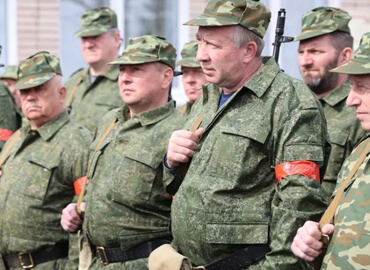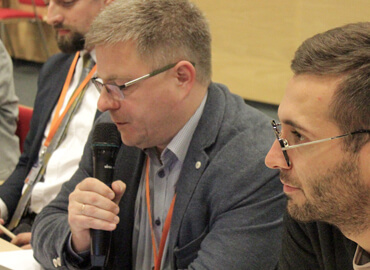iSANS has started monitoring changes of the content of pro-Kremlin propaganda in Belarus since 2020. Recently finished research has revealed that, during the preparation and the beginning of the full scale Russian invasion in Ukraine, the main storylines and content (narrative) of the Belarusian propaganda remained the same, but has undergone a serious transformation. During the research we conducted monitoring and analysis of statements, given by the main Belarusian media and Russian mass media during the first three quarters of the year 2022, and compared the data with our previous periods of monitoring – after the outbreak of Belarusian protest and until the beginning of the preparations for the full scale invasion into Ukraine (August 2020 — December 2021). Starting with this publication, main results of the research will be presented in a series of articles.
The closer it got to the war against Ukraine, the more aggressive the Kremlin’s mass media became. Starting with 2014, namely from the moment of the annexation of Crimea and military escalation of the Donbass conflict, main propaganda resources were directed to solving tasks of ideological mobilization of Russian society in the light of “foreign threats”. This rhetoric reached its peak in November-December 2021 as Kremlin’s plan on broadening the military confrontation became finally clear.
The efforts of Russian propaganda media were aimed, at that time, at justifying the aggression, maintaining “hysterical” level of public unity, and promoting the Kremlin’s ultimatum and obviously impossible demands for a democratic world.
Starting from September 2020, after the deployment of propagandists from Russia Today in Minsk, Belarusian mass media practically synchronized with Russian propaganda and followed in the wake the main Kremlin’s installations. Nonetheless, local Belarusian storylines – first and foremost – the fight with “internal enemies”, represented by the democratic opposition, independent media and participants of mass protest were dominant in Belarusian media landscape. Situation changed with preparations for the war.
According to the monitoring of iSANS end of 2020, main narratives (groups of stories – meta-narratives) of the Kremlin propaganda in Belarus were:
Narratives on Belarus:
- Belarus is part of the “Russian world”, Belarusians – part of the Russian population;
- Prosperous future for Belarus is only possible in the Union State with Russia or as part of Russia;
- Belarusian history is connected with Russian one or is a stranger and inglorious;
- Belarusian statehood, language and culture are defective;
- Belarusian national symbols – Nazi and inglorious;
- Belarusian opposition and activists – puppets of the West, nationalists and terrorists.
Narratives on Ukraine:
- Ukraine is ruled from abroad by the puppets of the West;
- Ukraine is ruled by Nazi junta, which came to power following coup d’état;
- Ukraine lacks legitimacy, it is an artificially created state, “fake state”;
- Without union with Russia and Belarus Ukraine is doomed to collapse;
- Russia has nothing to do with the conflict in Donbass;
- The Crimea legally belongs to Russia;
- “civil war” continues in Ukraine since 2014;
- Ukraine hatches aggressive plans towards Belarus;
- Ukraine hit the Malaysian Boeing (and other conspiracy theories).
Narratives about Poland and the Baltic States:
- Imperialist and annexationist plans of Poland;
- Poland, Lithuania, Latvia, Estonia – Russophobes hatching anti-Russian plans;
- They are in deep socio-economic crisis and moral degradation;
- Totalitarianism and Neo-Nazism in Poland and the Baltic States;
- Puppets of the EU and NATO.
Common anti-Western narratives:
- Russophobia and Fascist tendencies in Western countries;
- “the collective West” strives to weaken, divide or destroy Belarus, Russia and Ukraine;
- The West finances “color revolutions”, opposition and protests;
- The West undermines the Belarusian-Russian alliance and attacks Russia through Belarus;
- deep socio-economic crisis and moral degradation – in the West;
- European Union and EU Countries are the vassals of the USA and NATO;
- The West is split, which will lead to its inevitable collapse.
From the beginning of the Russian aggression against Ukraine these meta-narratives remained, however have undergone serious transformation. In particular, Belarusian stories were pushed out by the Russian ones to the periphery of the information agenda. Focus of the hatred shifted gradually from leaders of Belarusian democratic opposition and protest participants to Ukraine and the West.
Instead of former storylines, new ones appeared, which appearance was made possible by the outbreak of the war. First of all – it is justification of Russian aggression and complicity of the Lukashenka regime in it, justification of the inevitability of “military alliance” with Russia, where Belarus is a “reliable shield” of its Western borders, lies and threats against Ukraine, claims, that the West is responsible for the beginning of the war in Ukraine and not Russia, blaming Western sanctions against Russia for energy crisis, hushing up the crimes of the Russian army and the successes of the Armed Forces of Ukraine, etc.
Propaganda and its “retransmitters” in Belarus
Firstly, let’s agree on the terminology. Under “propaganda” we understand information policy of a state (or political party, business, etc.), which is aimed not at an objective and impartial information of the population with presentation of verified facts and variety of opinions on the situation, but at forming views of the audience that are beneficial to the state power at a certain moment, in other words – aimed at creating and maintaining a subjective false reality among the population which is beneficial for the political regime.
As a rule, propaganda can be easily distinguished from a regular media. Its signs are:
- one-sided presentation of information,
- selective approach to facts,
- unsubstantiated claims, without clear arguments and evidence,
- fixation on problems of other countries and societies, foreign threats, enemies, opponents of the government and state, and not on difficult questions of life and problems of an own country (economy, social system etc.).
Propaganda is also characterized by an aggressive and even hysterical style of discussion, insults, calls for violence, threats, and a tendency toward conspiracy theories. Propaganda actively uses disinformation and fakes.
The main sources of pro-Kremlin propaganda in Belarus are Russian and Belarusian officials, first and foremost the so called “President” Aliaksandr Lukashenka himself[1] and a broad circle of state employees, officers, which must, according to their status, give the information in that light, which is beneficial for the government. Staff “journalists” of propagandist mass media, as a rule, only transmit main directions, set by Lukashenka, to the population.
“Retransmitters” of the pro-Kremlin propaganda in Belarus – is an extensive network of Russian and Belarusian state and pro-state media, consisting of traditional media (TV, radio, print media, and online media) as well as «new» Internet media, including YouTube and Telegram channels, and social media accounts of propagandists and officials.
“Retransmitters” of the propaganda in Belarus can be divided into two categories:
1. Russian mass media, propagandists and media managers
These are the main federal media holdings whose channels are broadcast in Belarus, as well as a complex and ramified network of various online media outlets – military and conspiracy websites of an imperial nature, Telegram channels, Twitter accounts of main persons of Russian propaganda and officials, pages in social networks.
The former includes large state-owned media outlets (such as Channel One, VGTRK with Rossiya-1, Rossiya-24, etc.), as well as federal holdings formally separated from the state and established as non-profit organizations or private companies, but funded from the state budget, such as RT (formerly Russia Today), NTV, REN-TV, National Media Group, News Media, holding company Komsomolskaya Pravda, and others.
The second group is, for example, countless websites and channels “troll factories” and “media factories” of a businessman, media manager as well as founder and sponsor of PMC Wagner Evgenij Prigozhin, who is called “Putin’s cook”: media group “Patriot”, Internet research agency, RIA FNA (“Federal News Agency”), and many other “patriotic” an Z-oriented resources, imperial agencies Eurasia Daily, Regnum, Rex, the scrapheap Orthodox monopoly channels like Tsargrad TV and Spas, the Telegram channels of the so-called Russian «war correspondents»…
“Nuclear” audience of all these channels — the most conservative and reactionary part of the society: the siloviki, veterans, representatives of Cossack associations, as well as millions of employees of military-industrial complex and state employees.
In general, this «broth» of official state channels and private resources of unclear origin and financing is not specifically focused on the Belarusian audience and covers a wide range of topics, where news from Belarus has a certain place in the context of stories affecting Russia’s interests. However, there are also publications that focus on Belarus and the adjacent regions — Poland and the Baltic States, such as Sputnik Belarus and ruBaltic.ru.
The broadcasting of many Russian and Belarusian TV channels, as well as their websites, YouTube channels, and Facebook, Twitter, and Instagram pages, are blocked in the EU, the UK, the US, and other countries. In addition, the social networks and YouTube video hosting themselves remove and block the personal channels of the most prominent propagandists. All of this makes it somewhat difficult for researchers to find and identify propaganda narratives.
2. Belarusian mass media and propagandists
Propaganda media landscape in Belarus is represented by the state mass media outlets: TV channels STV (СТВ), National television ONT (ОНТ), TV News Agency ATN (АТН), information agency BelTA, newspapers “Minskaya Pravda”, “Sovetskaya Belarussia” (“Sovjet Belarus”) and others, also by pro-Russian online resources as IMHO Club, Teleskop, Politnavigator, personal Telegram Channels and YouTube channels of propaganda-“experts”, as well as Telegram Channels affiliated with special services or law enforcement agencies (e.g. “Yellow leaks” («Желтые сливы»)).
From the beginning of a full scale invasion to Ukraine all of them received new task – to mobilize Belarusian society in the wake of “foreign threats” according to Russian example, to justify Russian aggression and the complicity of Lukashenka regime. How it was done – will be explained in our article series “War propaganda in Belarus”.
The word “president” is put in the brackets not accidentally. iSANS stands in solidarity with the international community in regard that Lukashenka seized power as a result of falsified election, holds the power unlawfully and is a usurper. Lukashenka is not recognized as president by any of the democratic states.
Материал доступен на русском языке: Пропаганда войны в Беларуси. Часть 1. Прокремлевские сюжеты в беларусской пропаганде и их местные «ретрансляторы»










